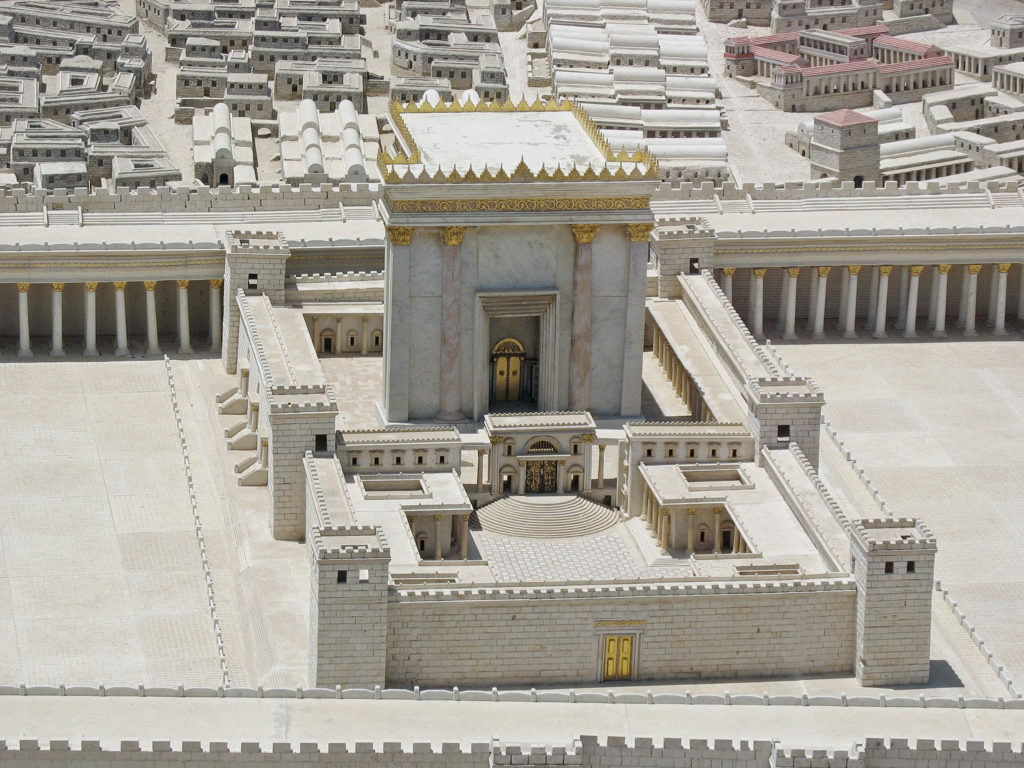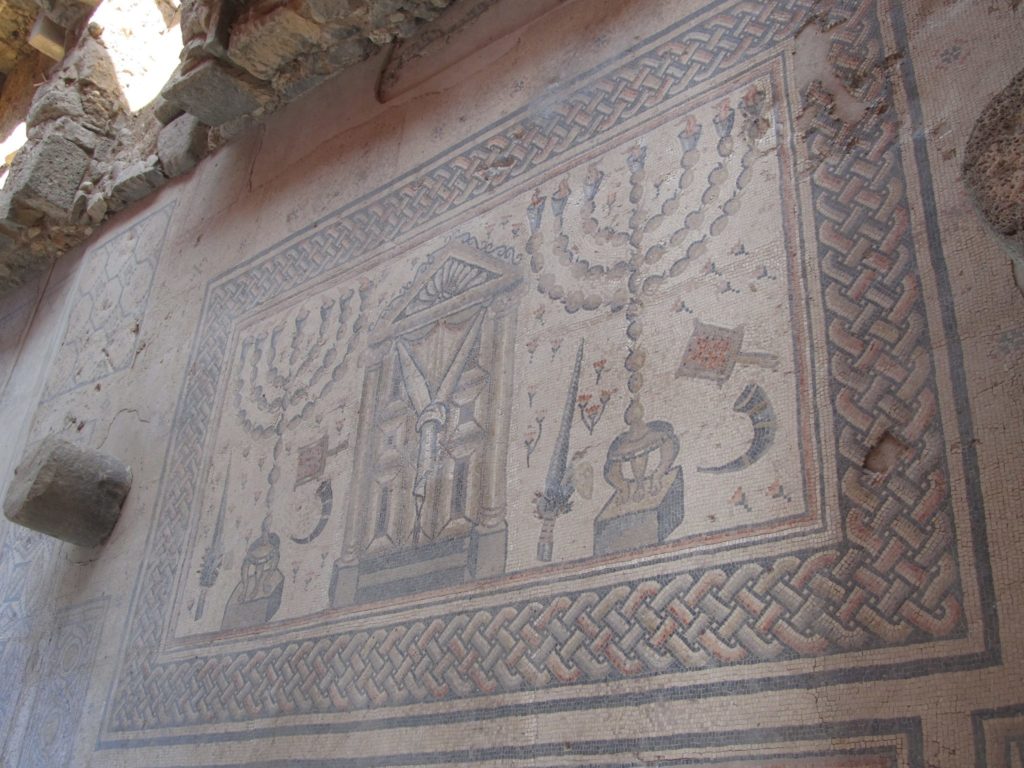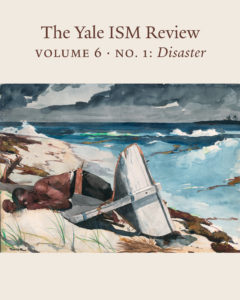Ruth Langer
Until its destruction, the Jerusalem Temple was the religious center of Jewish life. It was there that hereditary priests and levites offered the daily elaborate, covenant-maintaining sacrificial worship commanded by God in the Torah (Pentateuch). Individual Jews, even from afar, participated vicariously through their annual half-shekel tax (Ex 31:13-16) and by local gatherings when “their priests” took their turn (m. Taan. 3). Crowds gathered for the three annual pilgrimage festivals; others offered personal sacrifices when possible– in thanksgiving, or for purification, including from sins.[1]

The Second Jewish Temple. Model in the Israel Museum. This file is licensed under the Creative Commons Attribution 3.0 Unported license.
In the summer of 70 CE, the Romans utterly destroyed the entire edifice as they quashed the Judean revolt. After the failure of a second revolt in 135 CE, the Romans banished Jews from the city and built a temple to Jupiter on the Temple Mount. Because Deuteronomy 12 limited sacrificial worship to “the place which God will choose,” understood as Jerusalem, legitimate worship of God could not simply be transferred to another location. The depths of the existential crisis created cannot be overstated. It is the ḥurban, destruction, worse than the Holocaust. A well-known rabbinic teaching imagines the world as a three-legged stool, with the legs being Torah, worship, and acts of lovingkindness (m. Avot 1:2). The loss of the Temple’s worship thus had a broad destabilizing impact. Jews probably shared with their Greco-Roman neighbors an understanding that civilization’s stability depended on cultic worship. Christian memory is that the Romans persecuted early Christians precisely for threatening the state’s stability by refusing to participate in the Roman civic cults.[2]
The Romans did destroy the Judean state, but not the Jews and their relationship to their God. We know little about immediate Jewish responses to the tragedy except from rabbinic teachings dating from the third century onwards.[3] They record that Judaism retooled as an interim measure, expecting a divine salvific intervention to restore the nation and its worship system. These teachings formed the Jewish memory of this disaster and ongoing Jewish responses to it. Memories of the Temple and hopes for its restoration became central themes of the rabbinic system, especially its rituals. Only as nineteenth-century Jews became citizens in Christian lands did theological reforms and secularism recast this disaster as progress.
The rabbinic system encoded ritual responses in three main modes: salvage, ritualized mourning, and eschatological hope.
Salvage
The third-century rabbinic texts record that one of the first acts of the surviving rabbis after Temple sacrifices ceased was to determine possible points of continuity. Which non-sacrificial Temple rituals could persist, at least with some modification?
Thus, while Tabernacles celebrations with the palm branch (lulav) had taken place all seven days of the festival in the Temple but only one day outside it, Rabban Yochanan ben Zakkai ruled that the seven day celebration should now be universal. The rabbis debated where the ram’s horn (shofar) may be blown now when the New Year falls on the Sabbath: anywhere, at any rabbinic court, or only at the central court in Yavneh (m. RH 4:1-3)? Similarly, they ruled that priests should continue to bless the people (Nu 6:22-27) but in diminished form, as three separate blessings, substituting for God’s real name, and only raising their hands to shoulder height (m. Sotah 7:6).
Mosaics from 4th-6th century synagogue floors show that Temple symbols like these remained symbolically important. Indeed, the Temple’s seven-branched candelabrum (menorah), whether functional or depicted, was the primary symbol of Jews until the nineteenth century.[4]

Mosaic from the Hammat Tiberias synagogue floor. Tamar Mekom, Pikiwiki Israel. This file is licensed under the Creative Commons Attribution 2.5 Generic license.
The rabbis taught a liturgical system that fulfilled the most important functions of Temple rituals but in new, purely verbal forms. They expected universal Jewish participation in daily verbal prayer, corresponding to the times of the lost Temple’s sacrifices (m. Ber. 4:1, 3) and fulfilling their covenantal function. However, references to sacrificial worship and requests to restore it appear only scattered throughout the larger system of prayer. Every service pleads that God be satisfied with verbal worship as a substitute for sacrifices; the preliminary morning liturgy includes study passages about sacrifices.
On holidays, this becomes a more dominant theme. Biblical passages commanding the day’s sacrifice are read from the Torah as well as focusing the day’s additional service. This includes Yom Kippur, the Day of Atonement (Lev 16). Atonement for sins was a Temple function that transferred easily to this rabbinic, non-sacrificial context. While still evoking memories of the day’s elaborate Temple rituals, the day came to focus on confession and penitential prayer.[5] Atonement for many sins, though, could be sought every weekday, through the regular liturgy. Thus, the most significant Temple functions were modified or transferred, providing Jews with ritual continuity.
Ritualized Mourning
However, the discontinuities were also stark; mourning for lost rituals factored significantly in coping with the disaster. Zechariah (7:3, 8:18), in the wake of the restoration from Babylonia, knew fast days mourning the loss of the First Temple. After the Roman destruction, Jews merged these events into a single fast on a shared fifth-month anniversary, the Ninth of Av (mid-summer), preceded by a three-week penitential season. The liturgy for the day includes chanting the biblical book of Lamentations and a wealth of poetic laments (qinot) elaborating on the biblical book and reflecting on this and later disasters. Today, these include the Holocaust.
This sense of mourning traditionally also pervades daily life. Rabbinic texts recall that after the destruction, pietists sought to implement an all-pervasive mourning, banning consumption of meat and wine and even marriage and procreation. The rabbis argued this was unsustainable: not only would people openly rebel, resulting in outright disobedience to God’s Torah, but this path’s full logic would complete the Roman’s goal of wiping out Israel. Total, paralyzing mourning was logical, but it was not feasible. Instead, they advocated, a constant low-level of mourning should pervade Jewish life. One should leave an obvious patch unplastered in one’s house, something should remain uneaten at a meal, and a piece of jewelry should remain unworn (t. Sot. 15 end; b. BB 60b.).
The better-known custom of breaking something at a Jewish wedding communicates a similar message. The Talmud teaches that, “in this world,” i.e., after the destruction of the Temple, it is forbidden to be completely joyous. They tell of two different jubilant wedding celebrations where leading rabbis tempered the festivities by smashing expensive glassware (b. Ber. 30b-31a).[6] This precedent was integrated into subsequent ritual. Orthodox Jews today verbalize the meaning of this moment by first chanting, “If I forget you, O Jerusalem, let my right hand wither; let my tongue stick to my palate if I cease to think of you, if I do not keep Jerusalem in memory even at my happiest hour” (Ps 137:5-6). Some place ashes on the couples’ foreheads first. Then, after “breaking the glass,” the party begins.[7]
Eschatological Hope
This talmudic passage explicitly contrasts “this world”’s limited joy with that of the eschatological “world to come,” when, exile over, “our mouths will be filled with laughter and our tongues with joyous singing” (Ps 126:1-2). Such messianic hope pervades Jewish ritual life, a hope that embeds within it an expectation that God will end the current exile and restore an ideal human earthly existence. Thus, the seven blessings, recited for the bride and groom at the wedding ceremony and repeated at festive meals for the following week, ask God to cause the barren Jerusalem to know joy (implicitly, like that of this wedding) when her children are regathered to her. They praise God effusively for creating all possible dynamics of joy and ask that these sounds of joy soon fill Jerusalem (b. Ket. 8a).
Liturgical expressions of this hope for restoration appear constantly. The rabbinic weekday prayer petitions God to provide all the necessary elements of the messianically restored state, including its place of worship. The additional services of festive days not only recall the day’s sacrifices, but also pray for their restoration. For the last half-millennium, “Next year in Jerusalem!” has concluded the Passover Seder. In some synagogues, it concludes the Yom Kippur fast as well. More ancient is the Aramaic beginning of the Seder that moves from identification with enslaved, suffering ancestors to a hope that next year, we will gather as free people in the Land of Israel. Indeed, a restoration of the biblical worship system is only a part of Jewish messianic hopes which emerge from prophetic visions of a perfected world combined with expectations that God will, once again, end Israel’s exile and restore her national existence in her homeland.
Meshing this dream with modern realities is extremely complex – resulting in a range of conflicting understandings. Traditional, Orthodox Jews preserve the received rituals and pray for rebuilding the Temple, but differ among themselves both in their eagerness to reimplement sacrificial worship and also about the theological significance of today’s State of Israel and its ingathering of exiles. Only a tiny minority actively prepare to resume sacrificial worship on the Temple Mount, the current locus of the Muslim Dome of the Rock and Al Aqsa Mosque, the third holiest site in the Islamic world.[8]
For the liberal and even secular end of the Jewish spectrum, the State of Israel may or may not hold national and cultural significance, but they do not pray for restoration of the Temple and its sacrifices. These belong to history, and messianic times will manifest themselves primarily in the fulfillment of prophetic visions of universal peace and wellbeing.[9]
Liberal liturgies were adapted to reflect these evolving understandings. For instance, the Conservative movement’s prayer books shifted all discussions of Temple worship to the past tense, eliminating any prayers for its restoration. The Reform movement’s liturgies went further originally, eliminating all prayers about a return to Zion and any mention of sacrifices. From the nineteenth century, synagogues frequently were called “Temple” to indicate that they, with their verbal prayer, were now the only place of legitimate, God-desired, Jewish worship. Only in the 1970s did the first movement-wide American Reform prayer book, The Gates of Prayer, include recognition of a relationship to modern Israel.
Conclusion
Many of these same dynamics of salvage, mourning, and hope shape responses to other times of disaster. Is the Covid-19 pandemic one of them? Modern medicine has greatly reduced the plague’s lethality; modern communications technology has enabled much to be salvaged, to persist in diminished form. Certainly, most grieve for most aspects of their pre-pandemic world, and hope for its return, albeit marked by the lives lost. But perhaps because this hope is still very present, it does not look like this pandemic will create a radical ritual response, a major rethinking of the way the Jewish community stands before God, akin to the emergence of rabbinic liturgy in the aftermath of the ḥurban. Born out of disaster, that liturgy contains the seeds for surviving bad times and good.
 Ruth Langer is Professor of Jewish Studies in the Theology Department at Boston College and Interim Director of its Center for Christian-Jewish Learning. A graduate of Bryn Mawr College, she received her advanced degrees from Hebrew Union College – Jewish Institute of Religion (Cincinnati). She has published widely on the development of Jewish liturgy and ritual and on Christian-Jewish relations. For more information, see her website at https://sites.google.com/bc.edu/ruth-langer.
Ruth Langer is Professor of Jewish Studies in the Theology Department at Boston College and Interim Director of its Center for Christian-Jewish Learning. A graduate of Bryn Mawr College, she received her advanced degrees from Hebrew Union College – Jewish Institute of Religion (Cincinnati). She has published widely on the development of Jewish liturgy and ritual and on Christian-Jewish relations. For more information, see her website at https://sites.google.com/bc.edu/ruth-langer.
[1] For a description of the operation of the Temple and its role in the “common Judaism” of the time, see E. P. Sanders, Judaism: Practice and Belief, 63 BCE-66 CE (London/Philadelphia: SCM Press/Trinity Press International, 1992), chs. 5-7.
[2] See Candida R. Moss, Ancient Christian Martyrdom: Diverse Practices, Theologies, and Traditions (New Haven: Yale University Press, 2012), 8-16, who points to the limited sources that serve as reliable historical sources for this dynamic.
[3] Jonathan Klawans, “Josephus, the Rabbis, and Responses to Catastrophes Ancient and Modern,” Jewish Quarterly Review 100:2 (Spring 2010): 287-89.
[4] Steven Fine, The Menorah from the Bible to Modern Israel (Cambridge, MA: Harvard University Press, 2016), Ch. 2, “Flavian Rome to the Nineteenth Century.”
[5] Klawans, 304-306, argues that there is no evidence that Jews were particularly concerned over the loss of the various Temple rituals connected to repair of sin.
[6] In actual practice today, the choice of what to break is based on its fragility. Lightbulbs are a common choice, especially as their vacuum enhances the sound produced.
[7] For example, https://www.youtube.com/watch?v=nvOtcWEFWo8.
[8] See, for instance, the website of The Temple Institute in Jerusalem, https://templeinstitute.org/.
[9] For a fuller discussion of these dynamics, see my “Israel in Jewish Theologies,” in Enabling Dialogue About the Land: A Resource Book for Jews and Christians, Philip A. Cunningham, Ruth Langer, and Jesper Svartvik, eds. (New York, Mahwah, NJ: Paulist Press, 2020), 49-57.
